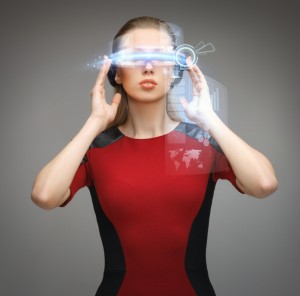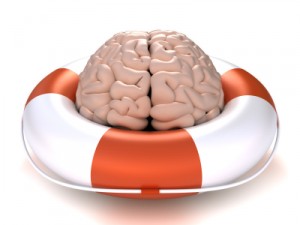Are You The Boss Of You?

I am the master of my fate. Aren’t I?
Like so many teenagers, I once believed that “I am the master of my fate, I am the captain of my soul.” I could take control, think for myself, and guide my own destiny.
It’s a wonderful thought and I really want to believe it’s true. But I keep finding more and more hidden persuaders that manipulate our thinking in unseen ways. In some cases, we manipulate ourselves by mis-framing a situation. In other cases, other people do the work for us.
Consider these situations and ask yourself: Are you the boss of you?
- When you eat potato chips, are you thinking for yourself? Or is some canny food scientist manipulating you by steering you towards your bliss point?
- When you gamble in a casino, are you in control or is the environment influencing you to spend a little more and stay a little longer?
- When you eat chocolate, is it because you love the taste or because the microbes in your gut are controlling your behavior?
- When you play the slot machines, are you deciding how much to spend or is a sophisticated algorithm dispensing just enough winnings to keep you hooked? Are you being addicted in the machine zone?
- When you read social media, do you decide how long to stay on or does a slow, steady drip of dopamine keep you engaged?
- When you don’t eat fish for 20 years, is it because you’re allergic or did you just never think to test your own assumptions? Did you frame yourself?
- When you go rock climbing, is it because you’re an adventurous spirit or because your slow heart beat tilts your life towards cheap thrills (and perhaps a life of crime)?
- When you chat with people in your neighborhood, do they express a wide range of opinions or do they all think more or less like you? When you surf the Internet, do you read only items that you agree with? Will that make you crazy?
- When you vote for a political candidate, is it because you have carefully considered all the issues and chosen the best candidate or because a cynical communications expert has got your goat with attributed belittlement?
- When you vote for stronger anti-crime laws, is it because you think they’ll actually work or are you succumbing to the vividness availability bias? (Vivid images of spectacular crimes are readily available to your memory so you vastly over-estimate their frequency).
- Why are so many restaurants painted red? Why is the woman in the picture (above) wearing a red outfit?
- Is the future ahead of you or behind you? Why did you make that choice?
- When you make a big decision for your company, you never let your biases get in the way, do you? Yet when other people make big decisions, they’re biased most of the time, aren’t they?
- When you choose a mate, are you thinking clearly or is sociobiology influencing your behavior?
- Did you carefully consider and consciously choose those activities that arouse you sexually or was the decision made for you by some combination of hormones, psychology, and genetics?
- Is your primary responsibility as an inhabitant of a given country to be a good citizen or a good consumer?
- When you buy something is it because you need it or because you want it? Perhaps you’re being manipulated by Sigmund Freud’s nephew, Edward Bernays, the founder of public relations. Or perhaps you’ve been brandwashed.
In The Century of the Self, a British video documentary, Adam Curtis argues that we were hopelessly manipulated in the 20th century by slick followers of Freud who invented public relations. Of course, video is our most emotional and least logical medium. So perhaps Curtis is manipulating us to believe that we’ve been manipulated. It’s food for thought.
(The Century of the Self consists of four one-hour documentaries produced for the BBC. You can watch the first one, Happiness Machines, by clicking here).
Turing, Flynn, and Numbskull

I need a life preserver.
In 1950, Alan Turing proposed a test to determine if a computer is artificially intelligent – or at least as intelligent as a human. A judge sits in a room with two computer terminals. One terminal connects to a human; the other connects to a computer. The judge carries on conversations through both terminals. If the judge cannot tell which terminal connects to a human and which to a computer, then the computer has passed the test. It’s intelligent.
There are, of course, two ways that a machine could pass the Turing test. On the one hand, machines might get smarter. On the other hand, people might get dumber. We believe that machines are indeed getting smarter. Apparently, people are getting dumber, too.
But wait, you say — Jim Flynn has documented that people are getting smarter, at least as measured by IQ. Flynn has shown that average IQ scores rose consistently during the 20th century in countries all around the world. On average, the increase was about three points per decade, but it rose as high as 7.7 points per decade in postwar Japan. This trend has become known as the Flynn Effect. (See also here).
Why did we get smarter in the 20th century? Nobody really knows but we assume that it’s a byproduct of better health, nutrition, and education. If so, we should see greater gains among the most disadvantaged people in any given country. And indeed, as New Scientist points out, that seems to be what happened in places like Denmark (which has a very rich trove of IQ tests). IQ scores for disadvantaged people increased consistently while scores for people who already were better off hardly budged at all. The low end was closing the gap with the high end.
At the same time, we were also getting taller. It seems logical to guess that improving health, nutrition, and environment caused us to become both taller and smarter. But average height seems to be leveling off now. Does that mean that average intelligence will do the same?
Actually, intelligence seems to be dropping. In Denmark, average IQ may have dropped 1.5 points since 1998. Other studies have found similar results in places like Australia, Finland, Sweden, and the UK.
Is this cause for worry? Jim Flynn doesn’t think so. He thinks the difference could be due to chance or to small changes in social and economic variables. It may just be an anomaly in the data.
But wait, there’s more to think about:
- Michael Woodley suggests that our average reaction times have dropped since the Victorian era. If true, we’re not as quick on the uptake as we used to be. Reaction time correlates (weakly) with general intelligence so perhaps we’re getting dumber as well as slower. (See also here).
- Richard Lynn and others have argued that smarter people have fewer kids and thus fail to pass along their genetic advantages. Over time, this would result in lower average intelligence in the population.
- Bruce Hood argues, in The Domesticated Brain, that our brains have shrunk by about the size of a tennis ball over the last 20,000 years. We know that the brains of cats and dogs shrank as they were domesticated; perhaps ours did, too.
It’s fair to point out that all of the data sets have some issues. Perhaps Victorian scientists measured reaction times differently than we do. If our brains are smaller than they were 20,000 years ago does that mean we’re dumber or could we be doing more with less? Do smart people really have fewer kids? Is that really what the data show or is it a popular but erroneous meme?
What’s it all mean? Hard to say exactly. I think I’ll go eat some blueberries, oily fish, and broccoli. That should make me smart enough to take the Turing test.
My Microbiome Made Me Do It

Her microbiome made her do it.
My sister craves chocolate. Is it her or her microbiome?
Your microbiome – the 100 trillion microscopic organs living in your body – may weigh up to three pounds (ca. 1,400 grams). In other words, it may be about as big as your brain. It may affect a wide range of diseases including obesity, muscular dystrophy, diabetes, multiple sclerosis, and chocolate abuse
Your microbiome affects disease, but can it affect your behavior? Can it force my sister to eat chocolate? Let’s start with the case of the cat and the mouse.
Toxoplasma gondii is a single-celled parasite that cycles between cat and mice. To complete its life cycle, it needs to pass from cat to mouse and back to a cat again. Toxoplasma lives in the cat’s gut so it’s fairly easy to get from the cat to the mouse – it travels in cat poop.
But how does it get back to the cat? Mice are, of course, deathly afraid of cats and scrupulously avoid them. But not if they’ve been infected with toxoplasma. Then they start wandering around in the open and may even be attracted to the smell of cats. They’re much more likely to be eaten by a cat. Joanne Webster, who studies these things at Imperial College, calls it “fatal feline attraction”.
How does it work? It’s complicated. Somehow the toxoplasma generates dopamine that interferes with the mouse’s brain messaging system. The interference changes the mouse’s behavior.
Remember dopamine? It’s a neurotransmitter that (among many other things) works with the reward system in the brain. Dopamine helps reward us – mice and humans — for good behavior. When we do something well, our systems release dopamine and we feel a sense of pleasure and reward. Problems with the dopamine system can affect a range of behaviors, including ADHD and schizophrenia.
So, is toxoplasma related to schizophrenia? Jaroslav Flegr thinks so. Flegr found that schizophrenics were three to four times more likely to be inflected with toxoplasma than non-schizophrenics. Similarly, E, Fuller Torrey found that women infected with the parasite “were more likely to give birth to schizophrenics to-be.”
Flegr also studied toxoplasma and road accidents. “Both drivers and pedestrians who had been in accidents were almost three times more likely to be infected than comparable individuals who had not been.” They also had poorer reaction times and shorter attention spans. All of this could induce riskier behavior – just like in mice.
What does all this have to do with my sister? Toxoplasma is just one example of the microbes living in the human body. As Carl Zimmer points out, it’s possible that other microbes are influencing our behavior in myriad ways, including food cravings. As Zimmer puts it, “Maybe the microbiome is our puppet master.”
Did you ever wonder why humans are called “social animals”? Perhaps it’s because we can be more successful by collaborating and building societies. Or perhaps it’s because our microbes want to travel from one human to another. It’s much easier on our microbes if we’re clustered together.
And food cravings? Zimmer points out that different microbes like different kinds of food. Perhaps their desires drive our cravings. Zimmer writes that, “Many people crave chocolate fiercely, but it isn’t an essential nutrient. … Perhaps … certain kinds of microbes that thrive on chocolate are coaxing us to feed them.”
If true, does this mean that my sister is not responsible for her chocolate craving? Is she just an innocent bystander, manipulated by her microbial puppet master? It’s an intriguing question that I’ll save for a future article. In the meantime, if you get in trouble with the law, I’d suggest that you say, “My microbiome made me do it.”
(For a related article on zombie spiders, click here).
The Future of 3D Printing (and Elliot)
 I don’t know if 3D printing will change the world, but I do know that it’s helping Elliot start up a new business in Berlin.
I don’t know if 3D printing will change the world, but I do know that it’s helping Elliot start up a new business in Berlin.
Elliot’s a good designer. He’s designed everything from 3D videos to websites to room dividers to packaging. But he has a special knack for furniture – especially furniture designed on a computer.
Using 3D software Elliot designed the table in the photos. He then built one, using a numerical controls (NC) laser to cut the wood and a 3D printer to create the red resin joints. (You can get them in any color you want).
The design incorporates both additive and subtractive manufacturing. Elliot creates the tabletop by cutting wood away – it’s subtractive. He creates the joints in a 3D printer by adding one layer of resin on top of another repetitively.
Elliot has now rented a studio in Berlin and is starting up a furniture design and manufacturing business, under the brand name Studio Elliot White. None of this would have been possible without 3D design software and printers.
So, is Elliot a harbinger of things to come? Well, maybe. A few days ago the New York Times had a lively discussion on the topic in  its Room For Debate section. Here are some highlights along with my ruminations.
its Room For Debate section. Here are some highlights along with my ruminations.
Big picture – the grand vision has been that we will all have 3D printers in our homes. We could order Elliot’s table (or bench or chair) and he would simply send us the design files for us to print at home. That seems unlikely, at least in the near term. Home printers just don’t produce the necessary quality.
Future schlock – Amazon recently opened its 3D printing store. You can create your own products. Unfortunately, most of it is schlock – like a 3D printed plastic dog bone. Even with such simple products, you don’t get to print it yourself. Amazon prints it and ships it to you.
Jet engine parts – some analysts suggest that 3D printing will always be low quality because of inherent weaknesses in additive technology. But General Electric has figured out how to print fuel nozzles for jet engines by printing layers of metal. By doing so, they reduce costs and lead times while improving quality.
 Clothes – I wouldn’t have thought of printing clothes but start-up companies are pushing the trend. Indeed, the US Army seems to think that it can clothe soldiers in high-tech printed uniforms for greater comfort and safety. And, yes, there is even a range of 3D printed bikinis.
Clothes – I wouldn’t have thought of printing clothes but start-up companies are pushing the trend. Indeed, the US Army seems to think that it can clothe soldiers in high-tech printed uniforms for greater comfort and safety. And, yes, there is even a range of 3D printed bikinis.
Food – yes, it’s possible to print food. I was heartened to learn that one of the first applications is to print chocolate onto other foods.
Guns – yep, printable guns are here. And here. They’re cheap and undetectable. But don’t worry. They can only fire a few bullets before they break.
Manufacturing – could 3D printing return manufacturing to advanced countries? Maybe. As one Room For Debate writer noted, manufacturing productivity has risen much more quickly than overall business productivity. Meanwhile, the cost of labor in China is rising at 10 to 15% per year. If these trends continue, on-shoring makes a lot more sense.
So, what’s the future? Well, once again, I think we’re caught in the hype cycle. The initial hype was intense. Now there’s a bit of disappointment as reality seeps in. But that’s usually followed by a rising productivity curve as entrepreneurs sort out which technologies fit which markets. I’m generally optimistic. Now … does anyone want to buy a table?
Sitting Still In a Room

Sit still!
In the late 1650s, the French mathematician and philosopher, Blaise Pascal, wrote an insightful sentence, “All of man’s problems stem from his inability to sit still in a room.”
Collected in Pascal’s unfinished Pensées, this little tweet from the 17th century has enlightened us for 350 years. In fact, it has recently received new impetus and momentum from an article in Science magazine.
Titled “Just think: The challenges of the disengaged mind”, the article reports on 11 different studies. Taken together, they show that people – and men especially – would rather receive electric shocks than sit alone in a room.
The article looks at default mode processing and asks two simple questions: “Do people choose to put themselves in default mode by disengaging with the external world? And when they are in this mode, is it a pleasing experience?” As the authors note, we might assume that it’s easier to guide our thoughts in “pleasant directions” when we disengage with the world. However, that’s not what they found.
To study these questions, the researchers asked students to sit still and alone in various locations (a research lab, a dorm room, etc.). They were simply asked to “entertain themselves with their thoughts….” After sitting still for six to 15 minutes, the students reported that it was hard to concentrate, their minds wandered, and, by and large, they didn’t enjoy the experience.
Maybe it’s just college students. But the researchers repeated the studies with people recruited from local churches and at a local farmer’s market. The results were quite similar. Indeed, the researchers found no evidence that demographic factors – gender, age, income, education, etc. – were producing the results. It seems that people from all walks of life just don’t like to sit alone and think.
The researchers then asked another question: “Would [the participants] rather do an unpleasant activity than no activity at all?” Was it just the sitting still that made people stir crazy? The researchers told participants that, instead of just sitting still, they could press a button and receive an electric shock.
With the electric shock in place, the results differed significantly by gender. Two-thirds of the men gave themselves at least one electric shock; only one-fourth of the women did. In other words, a majority of men seem to prefer pain over thought.
That’s not encouraging. I’ve always had faith in reason. I believe that, with patience and goodwill, we should be able to reason our way through our problems. But, as the researchers point out, our “… minds are difficult to control…and it may be particularly hard to steer our thoughts in pleasant directions and keep them there.”
Perhaps meditation training would help. Perhaps we can learn to manage our thoughts and enjoy the process of thinking. Ultimately, however, the researchers conclude that, “The untutored mind does not like to be alone with itself.” That’s just what Pascal said. We haven’t made much progress in 350 years.